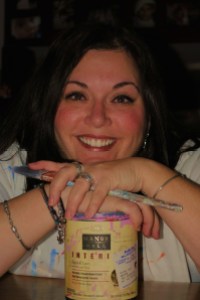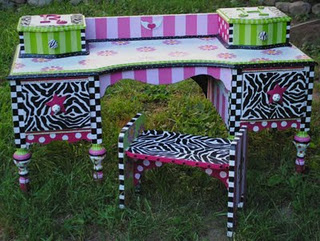Visual Arts
Not To Be Trashed: Guest Post by Mary Mollica
Today’s guest blogger is my old friend, Mary Mollica whom I have known since 1975 when we found each other in 2nd grade. Today, Mary recalls our most excellent high school art teacher, Carl Wenzel. She’s not lying about his quirky-awesomeness. My homeroom was next door (in the other art room) but I often hung out in his room. With one quick lesson, he helped Mary save something that she almost threw away. He may not remember doing this, but his words and actions changed her life….

TechSupport was relaxing, drawing in his notebook to complete an assignment for his art class.
“Can I show you something?” my husband interjected. He used to be a pretty good artist back in the day. “I want to show you how to look at that can of soda and really see it.”
“I kind of just want to draw,” Tech said.
My husband pulled a chair over to the kitchen table where our son was sitting. “I just want to show you something,” he said. “Will you just look?”
Tech kept his eyes on his notebook. “I will.” His hands gripped his pencil tightly. “In a little while.”
I addressed my husband. “Not every moment has to be a teachable moment…”
My husband glared at me. “Don’t do that.” He held up one hand. “You’re always undermining me. I just want to show him something.”
Insulted, my husband pushed back from the table, scraped the chair’s legs against the hardwood floors, and he stormed off into another room.
Tech’s hand continued to move. He wasn’t really looking at his can of soda. He was just coloring.
“You know,” I said. “Instead of making a big stink, you could’ve just listened to what he wanted to say.”
Tech bit his lip and continued drawing.
After a while, Hubby reappeared. “Now can I show you something?”
I could feel how much my husband wanted to show our son what he knew. How he wanted our child to see the world differently. How he wanted him to see shadows and light. How he wanted him to see a different perspective.
Tech looked at me, then at his father. I could see he was biting the inside of his cheek.
I imagine he felt outnumbered.
There are always two of us, and only one of him. He tries so hard to please.
My husband started again. He showed our son how the eye can lie. How colors can be different, not uniform. How a brown can of soda isn’t really brown when you are drawing it. If you look, it is gray and maroon. Even orange in places.
“That’s all I wanted to show you,” my husband said with some degree of satisfaction.
After all, he got what he wanted.
“Thanks,” Tech said with a blend of gratitude and sarcasm in his voice.
My husband’s cell phone rang and he answered it.
And Tech continued to draw with his brown pencil.
Not gray, no maroon, no orange. He only used brown: a Good Son’s quiet act of defiance.

What my husband didn’t know was that Tech and I had plans. We’d said that while he drew his picture of Dr. Brown’s Cream Soda, that I would write about the same topic.
I guess it didn’t go quite as planned.
Or maybe we all got it done in our own way.
Michel Foucault once wrote: “Where there is power there is also resistance.” Anyone experiencing any resistance lately?

Today’s guest blogger is my old friend, Mary Mollica whom I have known since 1975 when we found each other in 2nd grade. Mary and I have been in and out of each others lives for over 3 decades, but we really reconnected when we learned that we had both been blogging.
Mary’s professional blog, The Decorative Paintbrush, is a journey where she shows readers how she finds trash and turns it into treasure. (I was recently with her when she found a piece of crap leaning against a building and she circled back to get it, declaring with absolute certainty that she was going to turn it into something gorgeous. I am sure she has. I have seen what she can do.)
Mary’s personal blog is called 2moms5kids and that is a whole different kind of adventure, equally amazing. You can follow Mary on Twitter @thedpb.
Today, Mary recalls our most excellent high school art teacher, Carl Wenzel whose work can be found HERE. She’s not lying about his quirky-awesomeness. Note: While I took numerous art classes, I had nowhere near the artistic potential that Mary did. Some of us are artists and some of us are writers. And some of us are financial guys.
• • • • •
Not To Be Trashed
I remember the first time I stepped into his classroom. There was music playing, and the lights were off. Quel ambiance, right? I remember thinking this guy is either a total nut job or very cool. Turns out he was a bit of both, and I say that with total admiration. He’d probably admit that himself. Mr. Wenzel was, and still is, an amazing artist and, as an artist now myself, I’d have to admit, in order to be a good one, you have to be a bit of both!
Until ninth grade, I had taken art classes along with the rest of my peers. Pinch pots, papier maché, and abstract self-portraits cluttered my mother’s refrigerator. Like most young children I liked art – it was fun – but the first day I walked into Mr. Wenzel’s classroom, I knew things were going to be different. He ignited a passion for art inside of me like no other teacher had before.
Mr. Wenzel introduced me to techniques that enhanced my own creativity instead of trying to manipulate my work into a carbon copy of his own. He gave praise as well as constructive criticism, which, at first, I’ll admit was not easy to take. But along with the criticism, he always gave a solution that helped fix the problem.
I remember once we were getting ready for the annual art show. We all had to do a piece in hopes that it might be submitted. At the time, Mr. Wenzel was trying to teach us about atmospheric perspective (reducing value contrasts, and neutralizing colors in objects as they recede) and, for whatever reason, I was struggling with this concept.
My frustration started to build.
I wanted to be in the art show so badly, to show people what I could do, to prove I was a good artist, but my piece was not cooperating with me. At all.
I was irritated as I watched Mr. Wenzel walk around the room casually, giving kudos and words of praise to the other students. I wanted those accolades and looking at the junk in front of me, I knew I wasn’t going to get it. He finally stopped at my desk.
“So, what’s going on here?” He made a circle with his forefinger over my work.
“I don’t know…”(Yes, I was whining.) “I just can’t seem to get the hang of this.” I threw down my pencil in disgust. “I should just start over again.”
“Well you could start over…” he said sympathetically, “or you could try something else.” In one swift motion he grabbed a sheet of rice paper from a shallow drawer behind him, flipped the chair next to me around and snatched a big old jar of Elmer’s Glue.
He plopped down and started humming as he ripped the paper into large random pieces.
I watched him.
“Some of your biggest artistic mistakes will turn out to be some of your best creative work,” he said gluing down random slips of paper to the front of my project.
I had been trying to recreate a landscape from a picture I had cut from a magazine and although the background was wonderful, the fence in front was flat and unattractive. He slapped down the paper over the large fence posts, layering and molding them as he went, until finally they resembled old pieces of wood.
“A paper collé!” He exclaimed.
“A what?”
“A paper collé. A visual and tactile technique you can use to embellish certain areas.” He smiled and his mustache wiggled. “If you add color to these, they will stand out and make the background seem distant, like it should. Sort of 3D.”
I worked feverishly on that piece, falling in love with it more every day. My piece actually took first place in the art show that year and sold for a nice chunk of change. And to think — I had wanted to throw it in the trash.
Mr. Wenzel inspired me for many years after high school and helped me transform my hobby into a lifelong quest. His ability to arouse the imagination and motivate students was astounding. He taught us how to transform the mundane into the magnificent with very little effort. So, now when I screw up on a piece of art (or in life), I remain calm and remember Mr. Wenzel’s words.

What are some school art projects that you remember loving? Or hating?
• • •
If you have writing chops and are interested in submitting a memory about a teacher you had and can explain how that person helped you (or really screwed things up for you), as well as the life lesson you took away from the interaction, I’d love to hear from you! Contact Me. Essays should be around 700-800 words.
If you write for me, I’ll put your name on my page of favorite bloggers!